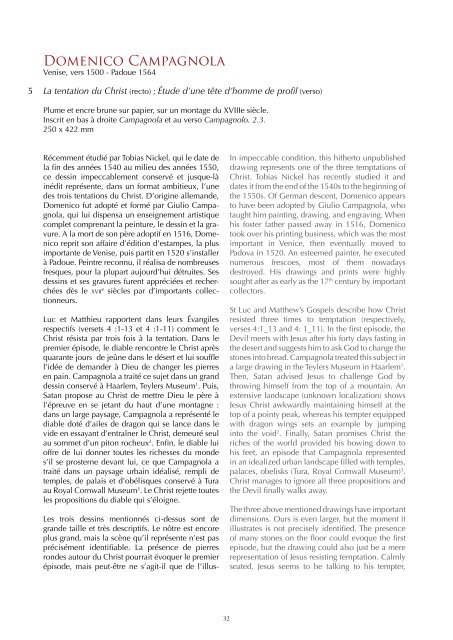You also want an ePaper? Increase the reach of your titles
YUMPU automatically turns print PDFs into web optimized ePapers that Google loves.
Domenico Campagnola<br />
Venise, vers 1500 - Padoue 1564<br />
5<br />
La tentati<strong>on</strong> du Christ (recto) ; Étu<strong>de</strong> d’une tête d’homme <strong>de</strong> profil (verso)<br />
Plume et encre brune <str<strong>on</strong>g>sur</str<strong>on</strong>g> papier, <str<strong>on</strong>g>sur</str<strong>on</strong>g> un m<strong>on</strong>tage du XVIIIe siècle.<br />
Inscrit en bas à droite Campagnola et au verso Campagnolo. 2.3.<br />
250 x 422 mm<br />
Récemment étudié par Tobias Nickel, qui le date <strong>de</strong><br />
la fin <strong>de</strong>s années 1540 au milieu <strong>de</strong>s années 1550,<br />
ce <strong>de</strong>ssin impeccablement c<strong>on</strong>servé et jusque-là<br />
inédit représente, dans un format ambitieux, l’une<br />
<strong>de</strong>s trois tentati<strong>on</strong>s du Christ. D’origine alleman<strong>de</strong>,<br />
Domenico fut adopté et formé par Giulio Campagnola,<br />
qui lui dispensa un enseignement artistique<br />
complet comprenant la peinture, le <strong>de</strong>ssin et la gravure.<br />
A la mort <strong>de</strong> s<strong>on</strong> père adoptif en 1516, Domenico<br />
reprit s<strong>on</strong> affaire d’éditi<strong>on</strong> d’estampes, la plus<br />
importante <strong>de</strong> Venise, puis partit en 1520 s’installer<br />
à Padoue. Peintre rec<strong>on</strong>nu, il réalisa <strong>de</strong> nombreuses<br />
fresques, pour la plupart aujourd’hui détruites. Ses<br />
<strong>de</strong>ssins et ses gravures furent appréciées et recherchées<br />
dès le xvii e siècles par d’importants collecti<strong>on</strong>neurs.<br />
<strong>Luc</strong> et Matthieu rapportent dans leurs Évangiles<br />
respectifs (versets 4 :1-13 et 4 :1-11) comment le<br />
Christ résista par trois fois à la tentati<strong>on</strong>. Dans le<br />
premier épiso<strong>de</strong>, le diable renc<strong>on</strong>tre le Christ après<br />
quarante jours <strong>de</strong> jeûne dans le désert et lui souffle<br />
l’idée <strong>de</strong> <strong>de</strong>man<strong>de</strong>r à Dieu <strong>de</strong> changer les pierres<br />
en pain. Campagnola a traité ce sujet dans un grand<br />
<strong>de</strong>ssin c<strong>on</strong>servé à Haarlem, Teylers Museum 1 . Puis,<br />
Satan propose au Christ <strong>de</strong> mettre Dieu le père à<br />
l’épreuve en se jetant du haut d’une m<strong>on</strong>tagne :<br />
dans un large paysage, Campagnola a représenté le<br />
diable doté d’ailes <strong>de</strong> drag<strong>on</strong> qui se lance dans le<br />
vi<strong>de</strong> en essayant d’entraîner le Christ, <strong>de</strong>meuré seul<br />
au sommet d’un pit<strong>on</strong> rocheux 2 . Enfin, le diable lui<br />
offre <strong>de</strong> lui d<strong>on</strong>ner toutes les richesses du m<strong>on</strong><strong>de</strong><br />
s’il se prosterne <strong>de</strong>vant lui, ce que Campagnola a<br />
traité dans un paysage urbain idéalisé, rempli <strong>de</strong><br />
temples, <strong>de</strong> palais et d’obélisques c<strong>on</strong>servé à Tura<br />
au Royal Cornwall Museum 3 . Le Christ rejette toutes<br />
les propositi<strong>on</strong>s du diable qui s’éloigne.<br />
Les trois <strong>de</strong>ssins menti<strong>on</strong>nés ci-<strong>de</strong>ssus s<strong>on</strong>t <strong>de</strong><br />
gran<strong>de</strong> taille et très <strong>de</strong>scriptifs. Le nôtre est encore<br />
plus grand, mais la scène qu’il représente n’est pas<br />
précisément i<strong>de</strong>ntifiable. La présence <strong>de</strong> pierres<br />
r<strong>on</strong><strong>de</strong>s autour du Christ pourrait évoquer le premier<br />
épiso<strong>de</strong>, mais peut-être ne s’agit-il que <strong>de</strong> l’illus-<br />
In impeccable c<strong>on</strong>diti<strong>on</strong>, this hitherto unpublished<br />
drawing represents <strong>on</strong>e of the three temptati<strong>on</strong>s of<br />
Christ. Tobias Nickel has recently studied it and<br />
dates it from the end of the 1540s to the beginning of<br />
the 1550s. Of German <strong>de</strong>scent, Domenico appears<br />
to have been adopted by Giulio Campagnola, who<br />
taught him painting, drawing, and engraving. When<br />
his foster father passed away in 1516, Domenico<br />
took over his printing business, which was the most<br />
important in Venice, then eventually moved to<br />
Padova in 1520. An esteemed painter, he executed<br />
numerous frescoes, most of them nowadays<br />
<strong>de</strong>stroyed. His drawings and prints were highly<br />
sought after as early as the 17 th century by important<br />
collectors.<br />
St <strong>Luc</strong> and Matthew’s Gospels <strong>de</strong>scribe how Christ<br />
resisted three times to temptati<strong>on</strong> (respectively,<br />
verses 4:1_13 and 4: 1_11). In the first episo<strong>de</strong>, the<br />
Devil meets with Jesus after his forty days fasting in<br />
the <strong>de</strong>sert and suggests him to ask God to change the<br />
st<strong>on</strong>es into bread. Campagnola treated this subject in<br />
a large drawing in the Teylers Museum in Haarlem 1 .<br />
Then, Satan advised Jesus to challenge God by<br />
throwing himself from the top of a mountain. An<br />
extensive landscape (unknown localizati<strong>on</strong>) shows<br />
Jesus Christ awkwardly maintaining himself at the<br />
top of a pointy peak, whereas his tempter equipped<br />
with drag<strong>on</strong> wings sets an example by jumping<br />
into the void 2 . Finally, Satan promises Christ the<br />
riches of the world provi<strong>de</strong>d his bowing down to<br />
his feet, an episo<strong>de</strong> that Campagnola represented<br />
in an i<strong>de</strong>alized urban landscape filled with temples,<br />
palaces, obelisks (Tura, Royal Cornwall Museum) 3 .<br />
Christ manages to ignore all three propositi<strong>on</strong>s and<br />
the Devil finally walks away.<br />
The three above menti<strong>on</strong>ed drawings have important<br />
dimensi<strong>on</strong>s. Ours is even larger, but the moment it<br />
illustrates is not precisely i<strong>de</strong>ntified. The presence<br />
of many st<strong>on</strong>es <strong>on</strong> the floor could evoque the first<br />
episo<strong>de</strong>, but the drawing could also just be a mere<br />
representati<strong>on</strong> of Jesus resisting temptati<strong>on</strong>. Calmly<br />
seated, Jesus seems to be talking to his tempter,<br />
32















